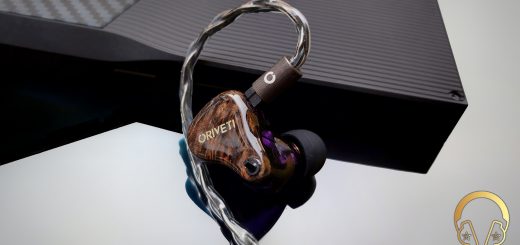Alpha & Delta KS1 IEM Review

Alpha & Delta KS1 IEM Review
Introduction:
Alpha & Delta is a Singapore based company that was founded by audiophiles with experience in the earphones retail industry.
The A&D KS1 that I will now review for you is the baby brother to the KS3. Like the KS3, the KS1’s housing is made of resin material that features a custom tuned 8mm graphene dual magnetic dynamic driver and a detachable 4 core cable with 2Pin connectors.

Disclaimer:
I would like to thank Alpha & Delta for providing me the KS1 IEM as review sample. I am not affiliated with Alpha & Delta beyond this review and these words reflect my true, unaltered, opinions about the product.
Price:
The Alpha & Delta KS1 is available under the link below;
Package and Accessories:
The Alpha & Delta KS1 has the same minimalistic packaging like the one of the KS3. It comes in a box with a transparent plastic top cover from where you can see the KS1 monitors and a second box in black color which has the product/company branding on the top that is printed in a nice looking shiny gold color.

The box of the KS1 is including the following contents;
- 1 x pair of AD KS1 In-Ear Monitor
- 1 x pieces of 4 Core Silver Plated Copper Cable with 2-Pin Connectors
- 4 x pairs of white silicone tips
- 3 x pairs of black silicone tips
- 1 x pair of foam tips
- 1 x piece of zipper case (fabric material)


Design, Build Quality and Fit:
The Alpha & Delta KS1 is a gorgeous looking In-Ear Monitor with a beautiful appearance which has a monitor shell made of 3D printed resin material. The monitors have a semi custom shape with a quite small size, same as the KS3 which fits perfectly & comfortable in to my ear concha with an average sized.

The overall build quality is fantastic especially considered to the price that is less than 50 USD. The KS1 is availably with four (4) different faceplate color options, which are Blue, Black, Red and Silver like my review unit.
On the top of monitor shell that we can faceplate is the AD logo in which is the shortcut for Alpha & Delta. The background of the faceplate has a marble like texture that looks pretty nice.

The main body is semi transparent and features part like the sound nozzle and the 2-Pin female connector.

Here is also a small bass vent; the Left & Right indicators and the description RESIN 3D PRINTING. The sound nozzle is made of metal material and has a mesh on the top to prevent the insertion of dust, ear wax, etc.
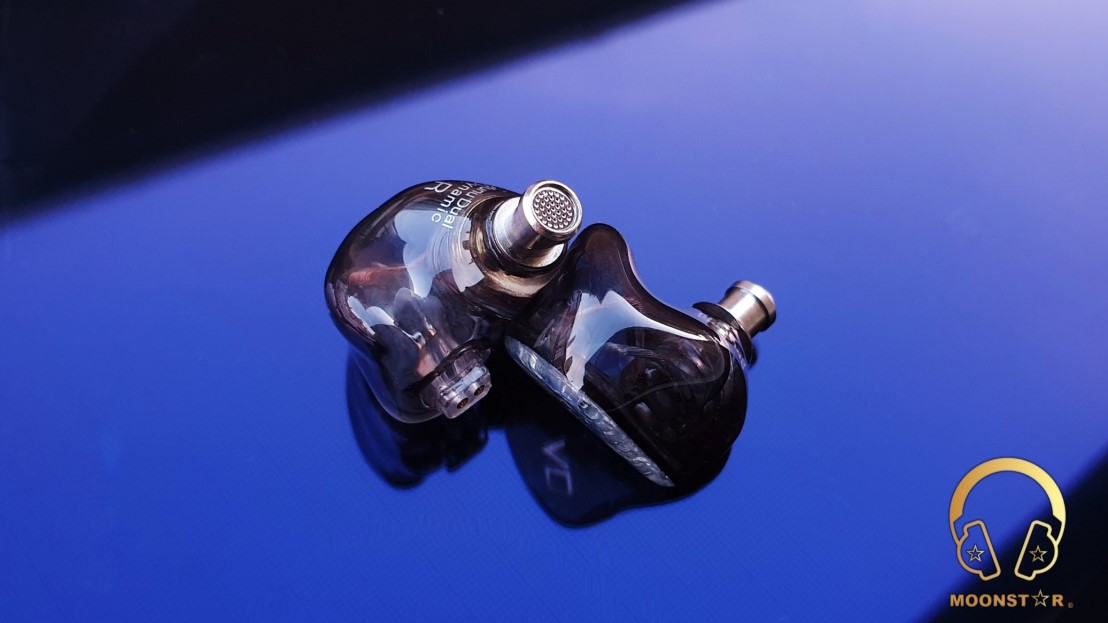
On the top of the monitor shell is the 0.78mm diameter 2Pin female connector which has a small elevation.

The isolation of the KS3 is on an average level due to the small size that offer great comfort but less isolation. But don’t get me wrong, the isolation is pretty enough to use it in environments such as bus, metro or train.
The Cable:
The Alpha & Delta KS1 comes with a 4 Core Silver Plated Copper cable with a black TPU insulation.

The 0.78mm diameter 2Pin male connectors fit tight and save to the female connectors of the monitor shell.

The housing of the connectors is made of plastic and each side has a left (blue) right (red) indicator. Near the connectors are heat-shrink ear guide that offers a better comfort on the go.
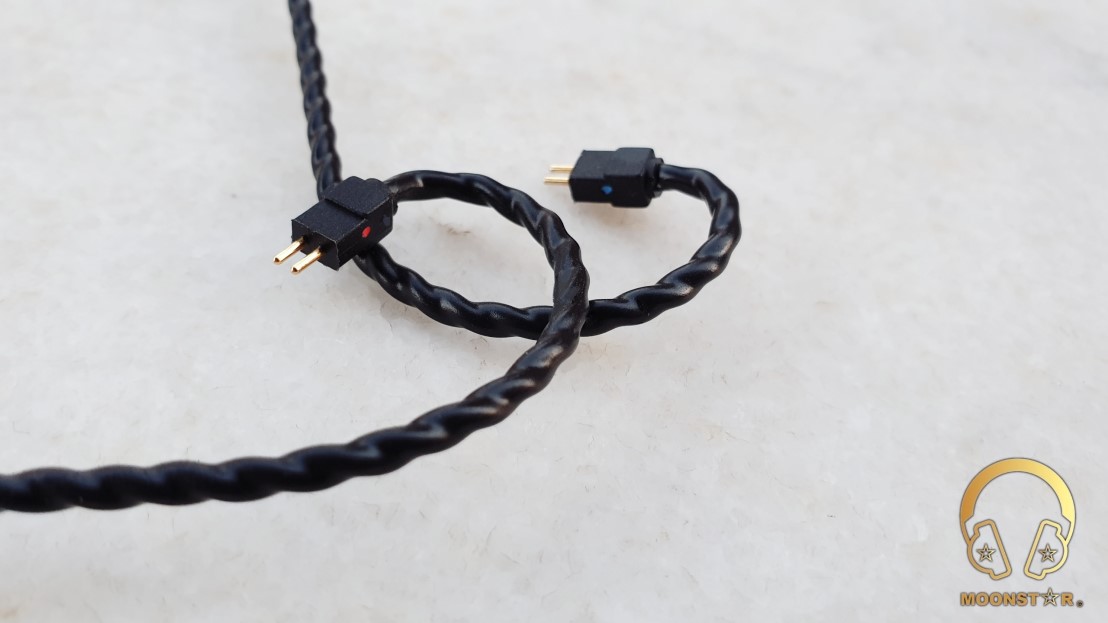
The Y-splitter of the cable is also in black color and is made of plastic material.
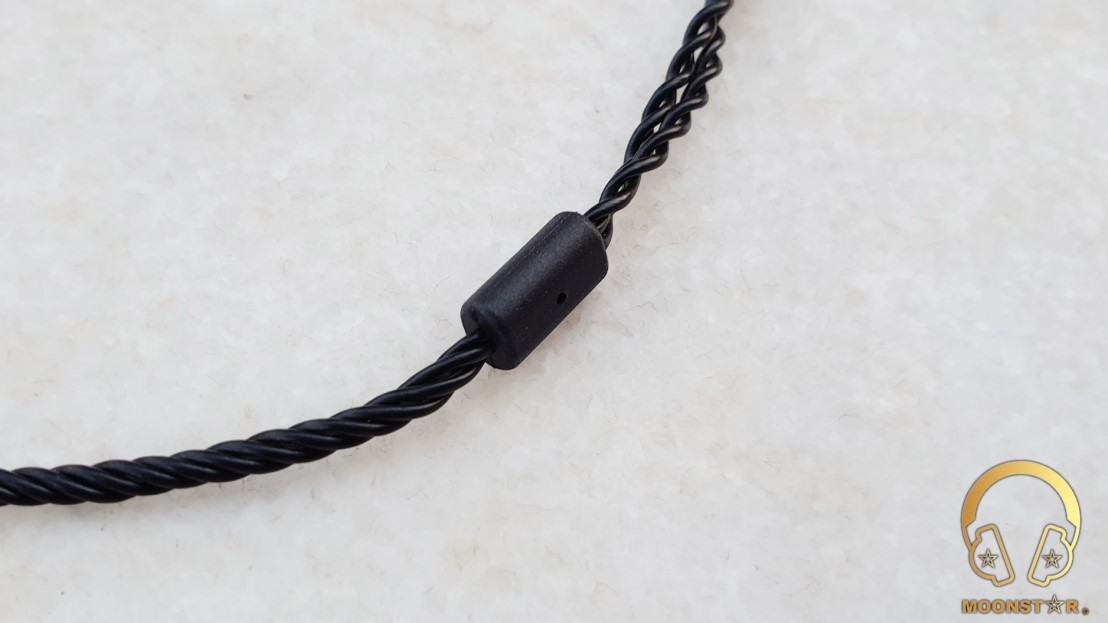
The 3.5mm TRS (unbalanced) headphone jack has a plastic housing with an L-angled profile which features a strain relief for extra protection.

Drivability:
The Alpha & Delta KS1 has a fairly low impedance of 16Ω and a sensitivity of approx. 105dB, which makes fairly compatible with relative weak sources like Smartphone’s, Tablet’, etc, while it shows its true potential if you pair it with a DAP or portable DAC/AMP and Amplifier.
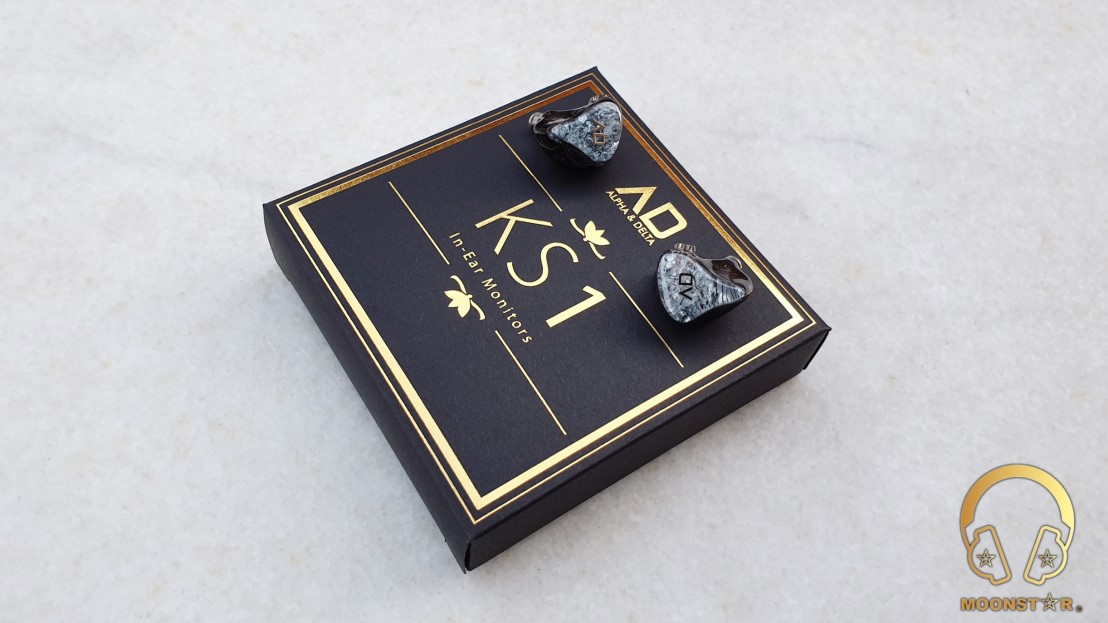
Technical Specifications:
- Driver Unit : 8mm graphene micro driver
- Impedance : 16 ohm
- Rated power : 1mW
- Freq. Resp. : 10 Hz- 20 Khz
- Sensitivity : 105 +/- db/mW
- Cable Length : 1.2m silver plated copper cable
- Plug : 3.5mm
Equipment’s used for this review:
- IEM : Alpha & Delta KS1, TFZ T2 Galaxy, Shozy Hibiki MKI
- DAP/DAC : Hidizs AP80 CU, FiiO M5, FiiO Q5s, iPad Air2, Galaxy S9+

Albums & tracks used for this review:
- Gogo Penguin – Raven (Flac 24bit/192kHz)
- Otto Liebert& Luna Negra – The River (DSF) – Binaural Recording
- Vivaldi – Le QuarttroStagioni “The Four Season” (Wav 24bit/88kHz)
- First Aid Kit – My Silver Lining (Flac 16bit/44.1kHz)
- London Grammar – Interlude (Live) (Flac 24bit/88kHz)
- Elton John – Your Song (Flac 24bit/192kHz)
- David Bowie – Black Star (Flac 24bit/96kHz)
- Eric Clapton – Unplugged Album (Flac 24bit/96kHz)
- Rush’s – Leave That Thing Alone (Flac 16bit/44.1kHz)
- Liquid Tension Experiment 2 – Acid Rain (Flac 16bit/44.1kHz)
- Metallica – Sad but True (Flac 24bit/96kHz)
- Megadeth – Sweating Bullets (Flac 24bit/96kHz)
- Slayer – Angel of Death (Flac 24bit/96kHz)
- Lorde – Royal (Flac 24bit/48kHz)
- Tom Player – Resonace Theory (16bit/44.1kHz)
- Massive Attack – Angel (Flac 24bit/192kHz)
- Portishead – The Hidden Camera (MP3 320kbps)
The Sound:
Alpha & Delta offers with the KS1 an IEM with a V-shaped sound signature which has a slightly warmer than neutral tonality. The bass is pretty and impactful, while it has a musical midrange and vivid but controlled upper midrange/treble presentation.
Please not that this sound analysis is written after a burn-in process of approx 90-100 hours. I have used the stock medium sized white silicone tips. The KS1 was paired with the Hidizs AP80 Cu, FiiO M5 and FiiO Q5s.

Bass:
The subbass region of Alpha & Delta KS1 shows a warmish tonality and offers a moderate level of depth and extension, along with a good amount of intensity that will satisfy most listeners with exception of bass-heads.
The midbass region on the other hand is fairly tight and impactful with that has enough musicality for most genres. The tonality of this frequency region is slightly warmer than neutral (warmish), while the detail retrieval and speed is quite good for a in ear monitor with a single dynamic driver at this price range.
Instruments like drums or bass guitars have a fairly natural tonality and timbre which is quite impressive for an entry level product.
The bass can be described in general as pretty fast, controlled with good transition to the lower midrange adds enough body and fullness to the presentation without to have negative effects, especially to the midrange like muddiness of mixings.

Midrange:
The midrange of the Alpha & Delta KS1 is slightly less pronounced compared to the lows and highs due to the V shaped sound signature. The overall tonality is a bit warmer than neutral depending to your source (DAP, DAC, AMP etc.).
The level of airiness and clarity is successful, and I can’t really complain a product like the KS1 at this price tag. The 8mm diameter dynamic driver is pretty good in terms of transparency and smoothness.
Female vocals do sound slightly more natural and detailed compared to male vocals due to the slightly higher intensity of upper midrange, which is a bit more highlighted compared to the lower midrange that shows otherwise a fairly good level of depth.
The separation and detail retrieval of instruments is quite good for an entry level In-Ear monitor. Instruments like violins or flutes are well accented without to sound harsh or too muddy. Other instruments like guitars or violas do have a good level of body and warmth.
The general midrange presentation is pretty lush and musical.

Upper Midrange & Treble:
The upper midrange of the Alpha & Delta KS1 is well highlighted without to be harsh or sibilant. Female voices and upper midrange intensive instruments have enough clarity and a fairly good amount of resolution without to show sharp dips or peaks which is a remarkable ability of the KS1.
The treble extension and control of the Alpha & Delta KS1 is just fine, while there is a good transition between upper midrange and lower treble. Some instruments like pianos, violins or voices like soprano female vocals do show a treble extension that is a bit but not annoying.
The treble quantity and intensity is neither too high nor too low and shows enough clarity and airiness for the most type of music genres.
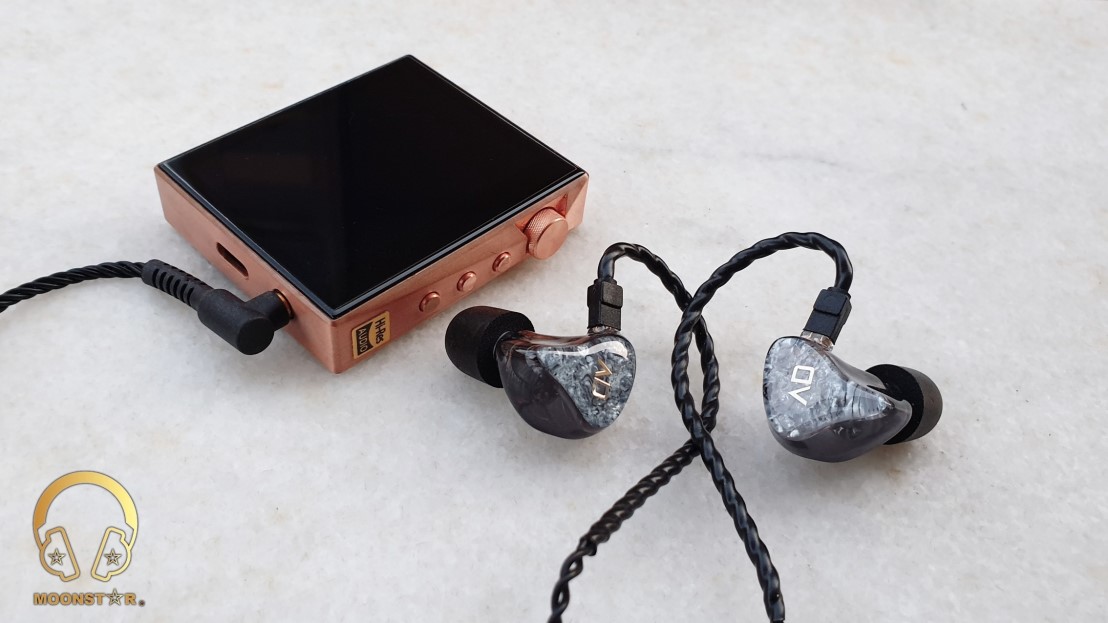
Soundstage:
The Alpha & Delta KS1 shows a sufficient performance in terms of soundstage width and depth. The soundstage width of the KS1 is slightly better compared to its depth, while the overall level of airiness and separation of instruments and vocals is pretty fine for a In-Ear Monitor at this price range.
Some Comparisons:
Alpha & Delta KS3 versus TFZ T2 Galaxy:
The TFZ T2 Galaxy is an In-Ear Monitor with a V shaped sound signature like the Alpha & Delta KS1. The bass of the TFZ T2 Galaxy is tight and pretty fast, while the midrange is full bodied and the treble region nicely highlighted.
The T2 Galaxy is easier to drive and sound noticeably louder at same volume levels paired with my iPad Air 2 tablet or my Galaxy S9 Plus phone. But don’t get me wrong you the KS1 are pretty suitable with that type of sources.
The TFZ T2 Galaxy shows more subbass rumble and midbass impact, while the Alpha & Delta KS1 has the upper hand in terms of subbass and midbass control. The bass of the KS1 is tighter and slightly faster in complex bass passages, while both IEM’s doesn’t show any negative situations like a bass that bleeds in to the midrange.
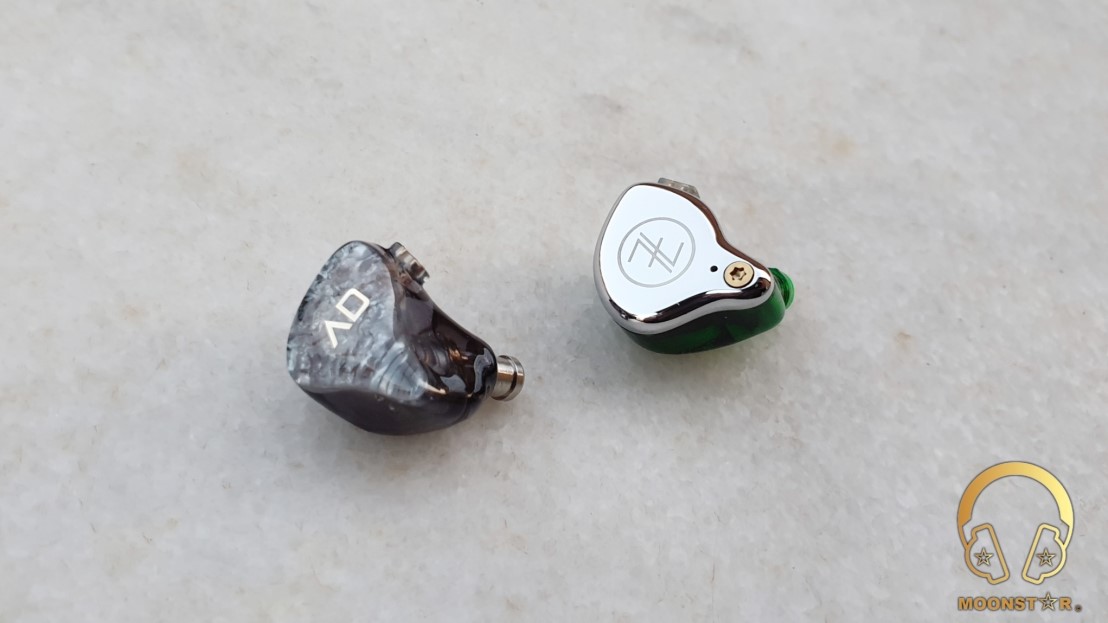
The midrange of both IEM’s shows a good level of clarity and detail retrieval, especially for their price tag. The Alpha & Delta KS1 has a warmer tonality in this frequency range than the TFZ T2 Galaxy. Both IEM’s are successful in terms of vocal/instruments clarity and resolution compared to many other products in this price range.
The upper midrange and treble region of the TFZ T2 Galaxy is more pronounced than those of the Alpha & Delta KS1 and shows also a slightly better level of extension. The KS1 on the other hand has the advantage in terms of upper midrange and treble control with its smoother and fatigue free tuning that makes it ideal for longer listening periods and for those who are sensitive to treble peaks.
Both the TFZ T2 Galaxy and the Alpha & Delta KS1 do show a sufficient performance in terms of soundstage accuracy. The T2 Galaxy has shows better depth while the KS1 has the upper hand in terms soundstage wideness.
Alpha & Delta KS3 versus SHOZY Hibiki MKI:
The Shozy Hibiki MKI has a fairly aggressive V shaped sound signature compared to the than Alpha & Delta KS1 that sounds more balanced in direct comparison.
The subbass and midbass region of the Hibiky MKI is more accented compared to those of the KS1, but sound a bit loose. The KS1 shows less subbass depth and rumble but is superior in terms of control and midbass tightness. Instruments like bass guitars and violas are quiet enjoyable with both IEM’s, but the Alpha & Delta KS1 has a more natural timbre.
The midrange of both In-Ear Monitors shows a good level of clarity and airiness. The Shozy Hibiki MKI sounds a bit dry and brighter in its tonality due to the highlighted upper midrange, while the Alpha & Delta KS1 has a lusher, more natural and fatigue free presentation.

The KS1 do show a better performance in terms of separation of instrument and vocals (especially female voices) do to the higher level of control and smoothness in the upper midrange region. The Hibiki MKI is a bit prone to sibilance especially with bad re-mastered tracks.
The Shozy Hibiki MKI has the upper hand in terms of upper midrange and treble extension compared to those of the KS1 which is superior in terms of separation and control in the higher frequency register. Instruments like violins and pianos do sound more natural and accurate with the KS1.
The soundstage performance of both IEM’s is on an average level. The main difference is that the Alpha & Delta KS1 shows a slightly better level of soundstage wideness.
Conclusion:
The Alpha & Delta KS1 is a product that offers a high value for your money. Its looks good, fits perfect especially if you have smaller sized ears and is pretty well made! But the most important part is the sound performance, which is based on a V shaped sound signature that is not overdone and quite suitable for many music genres.
Pros & Cons:
- + Well Tuned V shaped Sound Signature
- + Comfort & Build Quality
- + Value for the Pricex
- – None


